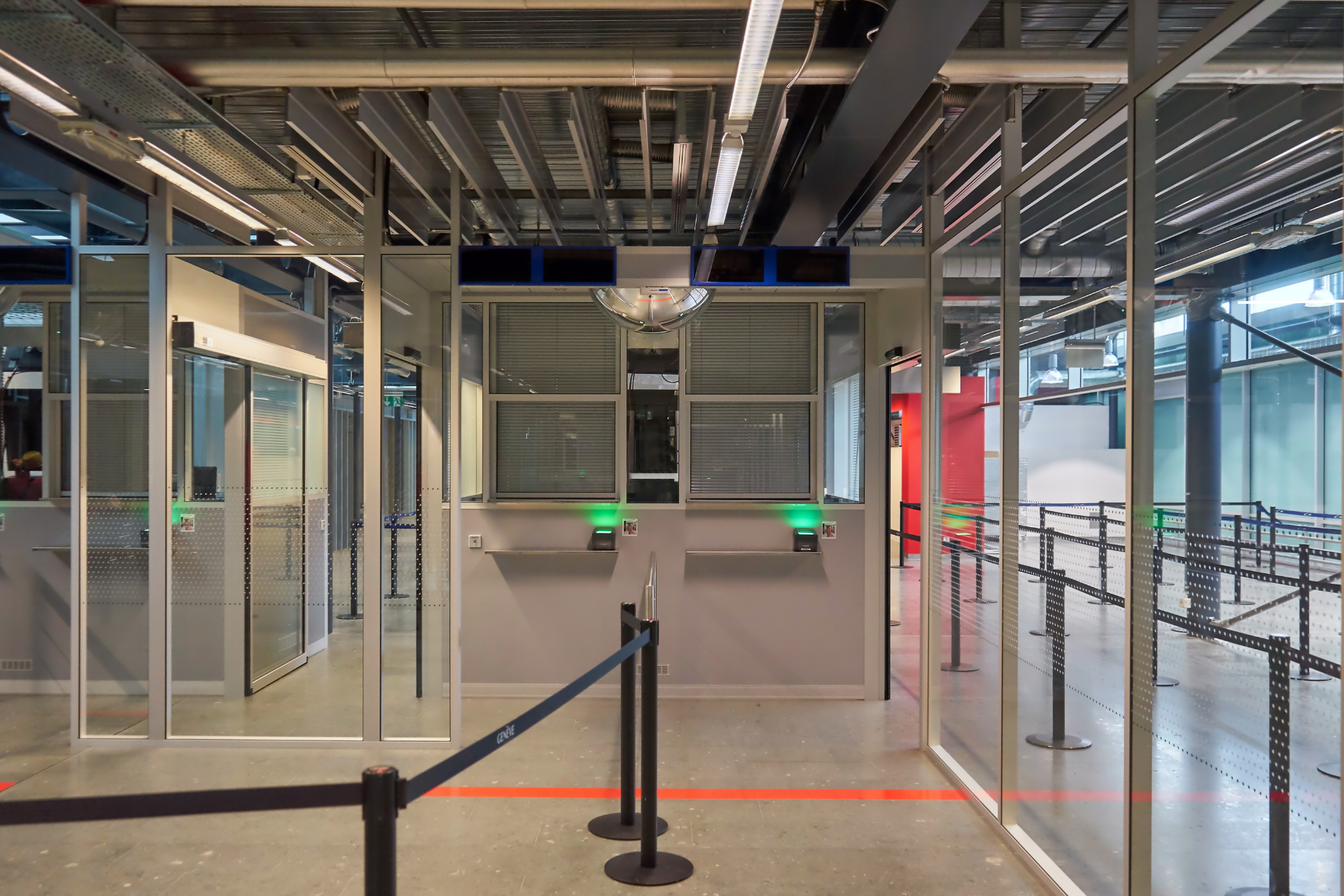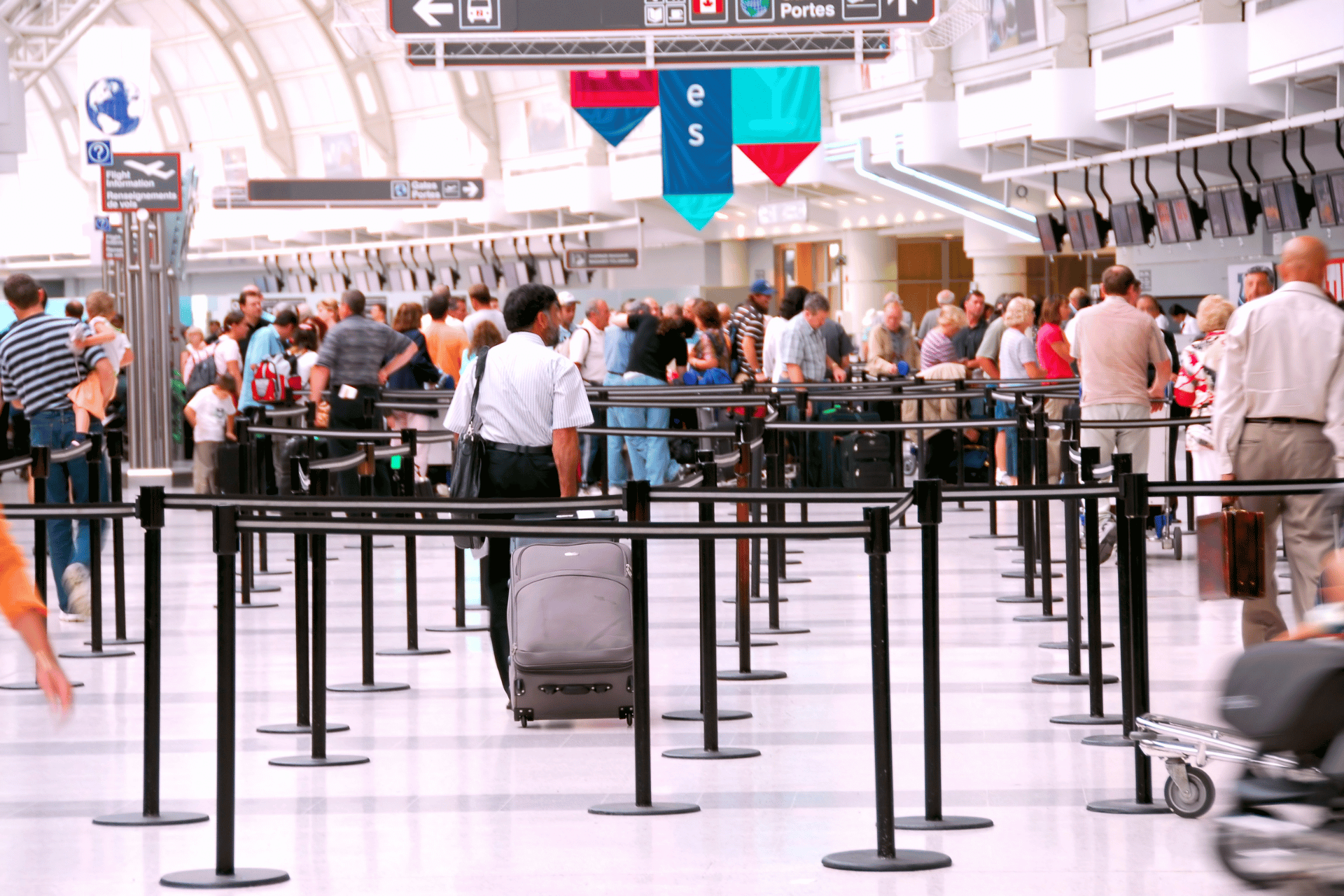As more automated control systems are introduced at borders across the world and both arrivals and departures become increasingly reliant on technological processes in the interest of speed and security, we thought it was a good time to answer the most common e-gate questions. Tap your question to jump straight to the answer!
What is an e-gate?
Which UK airports have e-gates?
How do e-gates work?
Who can use e-gates?
Which passports can’t be used at e-gates?
How to use an e-gate?
What happens if I get stopped?
Where can UK passport holders use e-gates in other countries?
Do I need to register for e-gates in my arrival country?
Can I use an e-gate as a foreign national visiting the UK?
What if my passport is damaged?
Why doesn’t my passport work at e-gates?
Do I have to use e-gates?
What is an e-gate?
 e-gates are automated, self-service gates that are used in UK airports – and some ports too – to speed up the passport control process. Many other countries have their own automated border control systems too – e-gates is sorta like the brand name for ours in the UK.
e-gates are automated, self-service gates that are used in UK airports – and some ports too – to speed up the passport control process. Many other countries have their own automated border control systems too – e-gates is sorta like the brand name for ours in the UK.
Which UK airports have e-gates?
e-gates are installed at several major UK airports, including:
- London Heathrow
- London Gatwick
- London Stansted
- London Luton
- Manchester Airport
- Birmingham Airport
- Edinburgh Airport
- Glasgow Airport
- Bristol Airport
- Newcastle Airport
- East Midlands Airport
How do e-gates work?
e-gates scan biometric data that’s unique to you – like your facial data, iris scans and fingerprints – and cross references it with the data that’s stored on your passport chip. A combination of ultra high res digital cameras, advanced imaging software, and scanning technology is used to re-create an image of your face. This image is compared with the photo on your passport, and cross-referenced against both national and international security databases. Your fingerprints and iris scans are checked against those stored on the system.
Basically, for us laymen, it’s a way for a machine to compare two photos side by side.
If any partial or full matches are found between your facial data and an image on a security database, a border control official will be called to do a manual check.
And if nothing gets flagged, you’ll be cleared to pass through the gate and that’s it! Passport control cleared – let the holiday begin!
Who can use e-gates?
If you have a biometric passport and are over 10 years old, you can use e-gates to enter the UK as long as you are:
- A British citizen
- An EU national
- A national of Australia, Canada, Iceland, Japan, Liechtenstein, New Zealand, Norway, Singapore, South Korea, Switzerland or the USA
- Enrolled as a ‘Registered Traveller’ from Andorra, Argentina, Bahamas, Belize, Botswana, Brazil, Brunei Darussalam, Chile, Costa Rica, Guatemala, Holy See, Hong Kong, Israel, Macau, Malaysia, Maldives, Mexico, Monaco, Nauru, Nicaragua, Panama, Papua New Guinea, Paraguay, St Vincent and the Grenadines, Samoa, Seychelles, Taiwan, Tonga, Trinidad and Tobago, Uruguay.
If you don’t fit into any of these criteria, you can’t use e-gates and will need to go through passport control.
Which passports can’t be used at e-gates?
Not all passports can be used at e-gates. Passports that are not eligible for use at UK airport e-gates include:
- Passports from a country that is NOT: the UK, Australia, Canada, Iceland, Japan, Liechtenstein, New Zealand, Norway, Singapore, South Korea, Switzerland, the USA or any EU country
- Passports for a child under 10 years old
- Non-biometric passports
Do I have to use e-gates?
 If you’re eligible to use e-gates you’ll be expected to use them, especially if there’s long queues at immigration. But you’re not legally obliged to use e-gates and at the end of the day it’s your choice whether to use the automated system or not.
If you’re eligible to use e-gates you’ll be expected to use them, especially if there’s long queues at immigration. But you’re not legally obliged to use e-gates and at the end of the day it’s your choice whether to use the automated system or not.
How to use an e-gate
Ah, the bit that always trips everyone up! The design can vary, but generally you’ll need to stand in a certain spot and place your passport on a scanner. The process to use an e-gate is (mostly) straightforward:
- Remove any hats, sunglasses, headwear etc in preparation for the facial scan.
- Place your passport on the scanner, positioning it so the photo page is in the correct position (usually this means the shiny photo page down first!)
- Keep looking at the point indicated while the cross-references are carried out (You’ll need to stand still for what feels like an eternity for this)
- Wait until the gates open then pass through
- If the software can’t match your face against the image, for example if the page is creased or damaged, an alert will trigger (think of the self-checkout light) and a border control officer will come to assist.
What happens if I get stopped at an e-gate?
Don’t worry – you’re not the first and you won’t be the last!
If you’re stopped at an e-gate, a border control official will come along. They probably won’t give you any details about why you’ve been stopped, or what went wrong. At the least, they’ll ask you a few questions. This may be to verify that you are who your passport says you are, to determine the nature of your visit, or to establish your relationship with the people you’re travelling with.
Do you need to register to use automated systems and e-gates at your destination?
Let’s say you’re flying from the UK. Do you need to register for the automated system in other countries?
The answer is, sometimes, yes. It’s best to check before you travel. In most cases you’ll need to register or apply online before you travel. You should be made aware of any visa / application requirements when you book, for example with an OTA or airline. But it’s always worth checking yourself well ahead of time.
For example, the EU’s Entry/Exit System (EES) will require all travellers from non-EU countries to register before they travel, when it is launched in October 2024. (Get more details on our blog here).
Similarly, the European Travel Information and Authorisation System (ETIAS), being launched in 2025, will have similar requirements. It’s set to be a straightforward process, similar to getting an ESTA for visiting the USA. And once you’ve been through the process, it’s attached to your passport and valid for three years. It’s one of those things that will be a slight hassle at first, then easy-peasy after that.
Using e-gates as a foreign national visiting the UK
 Can you use e-gates if you’re from Australia, the USA, or EU?
Can you use e-gates if you’re from Australia, the USA, or EU?
Yes, if your passport is issued by the US, Australia or a country in the European Union, your passport is valid for use at UK e-gates – but you’ll need to register before you travel.
If you’re not a national of any of these countries, you won’t be able to use an e-gate and you’ll need to get your passport stamped.
Where can UK passport holders use e-gates in other countries?
As a UK passport holder (with a blue or burgundy passport), you are eligible* to use** e-gates in these countries, at airports where e-gates are installed:
- Australia
- Belgium
- Cyprus
- France
- Ireland
- Italy
- Malaysia
- Netherlands – departure only
- New Zealand
- Portugal
- Singapore
- Thailand
- UAE
*Age restrictions for minors and children usually apply. Please check the requirements for your specific destination.
**Pre-registration may be required ahead of travel.
What if my passport is damaged?
If your passport is damaged, you really shouldn’t be travelling with it anyway as you risk being stopped from leaving the country, or refused entry to another country.
What counts as damage? According to the UK Government website, your passport is considered damaged if:
- you cannot read any of your details
- any of the pages are ripped, cut or missing
- there are holes, cuts or rips in the cover
- the cover is coming away
- there are stains on the pages (for example, ink or water damage)
In particular, if there’s any damage at all to your photo page, it’s likely the e-gate won’t work and you’ll need to join the queue of people that can’t use e-gates. AND you risk not being able to travel with it anyway. Travelling with a passport that’s damaged in any way is a seriously risky business – one that we wouldn’t recommend, either – unless you like throwing money away.
Why doesn’t my passport work at e-gates?
There are several reasons your passport may not work at e-gates or automated entry systems, such as:
Damaged Passports: Tears, water damage, or significant wear can interfere with scanning and prevent the information from being read.
Invalid or Expired Passports: Passports must be valid and not expired.
Incorrect Positioning: The passport must be placed correctly on the scanner.
Biometric Chip Issues: Faulty or damaged biometric chips can prevent successful scanning.
Technical Issues: Occasionally, technical glitches with the e-gate itself can cause problems.
Database Alerts: If there are any alerts or restrictions associated with the passport. Times your passport is likely to be ‘flagged’ include: when there’s a warrant out for your arrest (nationally or internationally), you’re undergoing investigation for a criminal offence, you’re on a Watch List or have been involved in terrorist activity, you’re on bail awaiting sentencing, you’re on the Sex Offenders Register, or are taking children out of the country without parental permission.
Other Anomalies: It could be that your face shares a number of matching data points to another face that is listed on a database somewhere. Some people do find that their passport is consistently flagged at e-gates, often mysteriously and with no explanation. It’s just one of those things. Take it as a compliment, we would.




